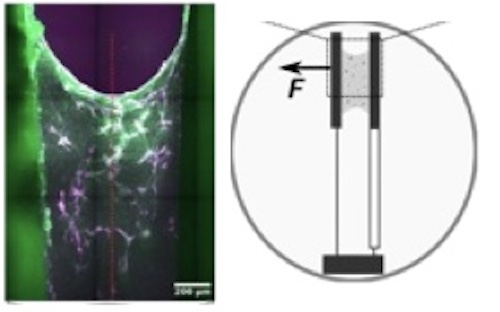Active mechanics of in vitro soft fibrous tissue
Research project of Mihaly D'Esposito, student of the Soft Nanosciences programm of GS@UGA, at the LiPHy, Grenoble
Fibrous tissue, like tendons or cancer stroma, are made of networks of fibers within which living cells are embedded. Cells constantly remodel these fibers using both chemical and mechanical means. Using an in vitro system similar to [1], our collaborator Jonathan Fouchard in Paris is able to measure how this remodelling leads to an evolution of the mechanical properties of the tissue.
The purpose of this project is to use zero-dimensional mechanical models to try to reproduce the key aspects of the mechanical properties of fibrous tissue with and without cells in different conditions. This will take the form of a visco-elastic model that will include pre-stress terms, which can model the consequences of the activity of cells [2]. Based on the variation of mechanical properties that is observed, we will formulate hypotheses on the way cells modify the network of fibers (stretching of fibers, creation of new bonds between them,…).
[1] Khalilgharibi, N., Fouchard, J., Asadipour, N., Barrientos, R., Duda, M., Bonfanti, A., ... & Charras, G. (2019). Stress relaxation in epithelial monolayers is controlled by the actomyosin cortex. Nature physics, 15(8), 839-847. https://www.ncbi.nlm.nih.gov/pmc/articles/PMC7116713/
[2] A. Erlich, J. Étienne, J. Fouchard and Tom Wyatt, 2022. Review: How dynamic prestress governs the shape of living systems, from the subcellular to tissue scale. Interface Focus 12(6):058101. arXiv:2209.01440
Published on January 18, 2024
Updated on September 4, 2024
